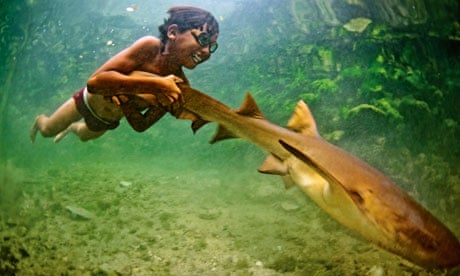Diana Botutihe was born at sea. Now in her 50s, she has spent her entire life on boats that are typically just 5m long and 1.5m wide. She visits land only to trade fish for staples such as rice and water, and her boat is filled with the accoutrements of everyday living – jerry cans, blackened stockpots, plastic utensils, a kerosene lamp and a pair of pot plants.
Diana is one of the world's last marine nomads; a member of the Bajau ethnic group, a Malay people who have lived at sea for centuries, plying a tract of ocean between the Philippines, Malaysia and Indonesia. The origins of the Bajau diaspora are recounted in the legend of a princess from Johor, Malaysia, who was washed away in a flash flood. Her grief-stricken father ordered his subjects to depart, returning only when they'd found his daughter.
Over generations, the Bajau adapted to their maritime environment and, though marginalised, their knowledge was revered by the great Malay sultans, who counted on them to establish and protect trade routes. They are highly skilled free divers, plunging to depths of 30m and more to hunt pelagic fish or search for pearls and sea cucumbers – a delicacy among the Bajau and a commodity they have traded for centuries.
Since diving is an everyday activity, the Bajau deliberately rupture their eardrums at an early age. "You bleed from your ears and nose, and you have to spend a week lying down because of the dizziness," says Imran Lahassan, of the community of Torosiaje in North Sulawesi, Indonesia. "After that you can dive without pain." Unsurprisingly, most older Bajau are hard of hearing. When diving, they wear hand-carved wooden goggles with glass lenses, hunting with spear guns fashioned from boat timber, tyre rubber and scrap metal.
The number of Bajau living on traditional lepa-lepa boats (narrow, high-prowed vessels, highly prized among the region's coastal populations) is dwindling fast, however. Nomadism has always been at odds with the fixed boundaries of the nation state, and over the last few decades controversial government programmes have forced most Bajau to settle on land. Today, many live in stilt villages such as Torosiaje, though the settlement is unique in that it lies a full kilometre out to sea.
Ane Kasim and her son Ramdan spend six months at a time on their lepa-lepa, subsisting on whatever they can harvest from the reefs. At dusk, they gather with the other boats in the lee of a small island, beside a mangrove forest where the water is calm. They build small fires in the sterns, grilling crustaceans and boiling thin mollusc stews. Their connection with the natural surroundings is vital: "I love being at sea – fishing, rowing, just feeling everything, the cold, the heat," Ane says.
It's not an easy life. Most lepa-lepa have rudimentary engines, but Ane can't afford one. "When I go to Torosiaje, I have to row. We don't have anything; my husband died from the cramp." She means decompression sickness, or the bends. These days, those who can afford it dive using compressors. Air is pumped through a garden hose so divers can go deeper for longer – 40m or more. Unaware of the need to restrict their exposure to pressure, countless Bajau have ended up crippled or killed by deadly nitrogen bubbles in their bloodstream.
The practice continues, however, because it's lucrative – especially when potassium cyanide is involved. Cyanide fishing was first introduced in the Philippines by Hong Kong fishing boats looking for reef species such as grouper and Napoleon wrasse to satisfy seafood restaurants' rising demand for live fish. It quickly spread throughout the Coral Triangle, a bio-region that spans six south-east Asian countries and is home to the planet's greatest diversity of marine species, including 76% of all known corals. Divers use plastic bottles to puff poisonous clouds at target species, stunning them and damaging the coral habitat. Today, the industry is worth upwards of $800m a year, according to research by WWF.
Torosiaje used to be flanked by teeming reefs; now there are only wastelands of broken coral, the legacy of years of dynamite and cyanide fishing. It's a common story throughout the Coral Triangle – communities destroying the environment that sustains them, driven by voracious global markets. Thankfully, things are beginning to change. Charities such as WWF and Conservation International are helping create marine management programmes that encourage sustainability through no-fish zones and a return to traditional fishing methods. It is often the Bajau who pass on such programmes to local communities.
Traditional Bajau cosmology – a combination of animism and Islam – reveals a complex relationship with the ocean, which for them is a multifarious and living entity. There are spirits in currents and tides, in coral reefs and mangroves. Such reverence and knowledge could be used to conserve rather than destroy.
See more of James Morgan's photographs of the Bajau at jamesmorganphotography.co.uk
